This Salmon Quinoa Bowl is a terrific way to use up leftover roasted vegetables. Repurpose those leftovers into an easy, fast, and nutritious weeknight meal that everyone will love. And if you don’t have leftover veggies hanging around? No worries. Even factoring in roasting time, this colorful quinoa bowl is ready in less than 45 minutes.

Grain bowls are all the rage, and there’s no better pairing for simple pan-seared salmon than nutty quinoa and tender roasted vegetables. Beyond being both delicious and nutritious, grain bowls are super practical.
You throw some leftover grains and bits of veggies into a vessel, top it with something proteiny, something crunchy, and something saucy, and you have a whole meal. They’re like jeggings (the good ones) – flexible, flattering, useful, and available to style in endless combinations. They showcase the best and hide the rest. Okay, so maybe jeggings is the wrong equivalent. But that does not negate the brilliance of the grain bowl. I see many of these guys in our future. You’re welcome.
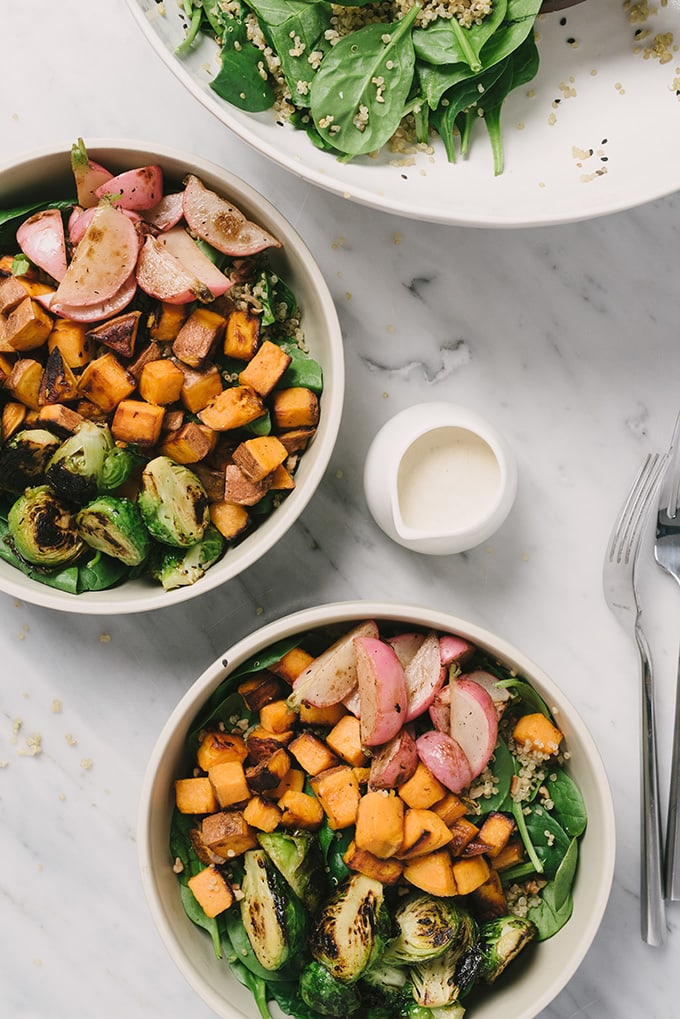
Pin it now! Click here to pin this Salmon Quinoa Bowl to your recipes board on Pinterest.
Salmon Quinoa Bowl Recipe Notes
Based on my “research” (ahem…googling), there is a definitive(ish) formula for grain bowls, and it goes like so: grain + veggie + protein + crunch + sauce = awesome
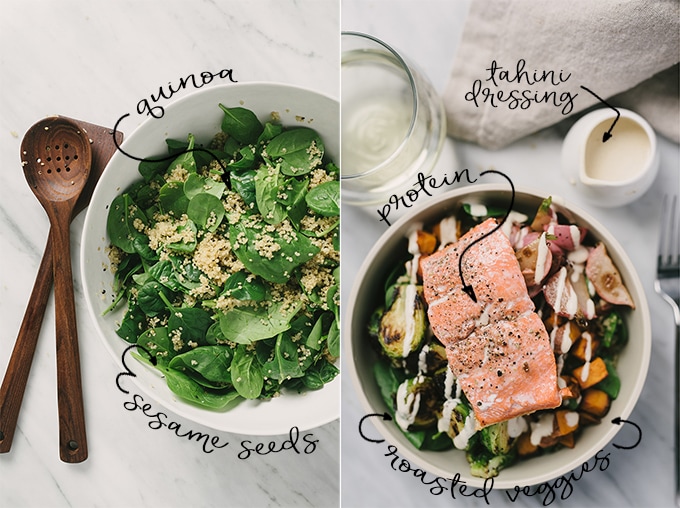
I made this salmon quinoa bowl with various leftover roasted vegetables, and it came together really fast for a less-than-30-minute weeknight meal.
To reheat leftover vegetables, toss them into a hot skillet with just a touch of olive or avocado oil. Sautee them over high for 2-3 minutes to reinvigorate their crisp, then reduce the heat to medium and sautee an additional 2-3 minutes until warmed through.
If you don’t have any leftover vegetables on hand, I’ve written the recipes instructions up for fresh vegetables so that you can make it from scratch. I love the colorful combination of brussels sprouts, radishes, and sweet potatoes in this salad, but please personalize to your own beat.
This type of meal is really popular in our house because it pleases all of the palates. It has enough variety to satisfy the adults, yet can be deconstructed enough to provide a colorful and nutrient-dense meal that my child will actually eat. It’s also super pretty. And economical. And tasty. Now, go forth and eat the grain rainbow.
How to Cook Salmon Perfectly Every Time
If you’re new to cooking and salmon scares you, I feel you sister (or brother). But like every recipe I’ll ever share here, it’s really not the hard as long as you have the right tools, some patience, and a healthy dose of prudence.
I find it much easier to properly cook an individual portion of salmon (about four ounces) instead of the whole fillet. I almost always pan-sear salmon instead of baking it to achieve that crispy outside, tender inside situation.
Speaking of tools, a fish spatula is very useful. If you don’t have one, a regular spatula is totally fine, but a fish-specific spatula will make the process of flipping a lot easier and will also ensure proper fat drainage when removing from the pan.
As for pans, I’m a cast iron devotee, but I definitely reach for a non-stick skillet for delicate protein like salmon.
Here’s how to cook a salmon filet perfectly every time:
- Step 1: Bring the fish to room temperature. Pull the salmon out of the fridge 20 or 25 minutes before you want to cook and let it sit on the counter.
- Step 2: When you’re ready to cook, heat up a skillet over a medium-high flame. Slice the fillet into equal sized, individual portions. Pat each fillet dry with a cotton kitchen towel or paper towel. This will help the fish get nice and crisp on the outside. Season the flesh with sea salt and cracked pepper.
- Step 3: One the pan is nice and hot (or when a few drops of water sizzle and evaporate immediately), add about a tablespoon of high-heat friendly fat, like avocado oil or coconut oil, to the pan. Allow the oil to heat for about a minute.
- Step 4: Add the fillets to the pan skin-side down and then DO NOT TOUCH THEM. Just let ’em cook. If you move them too soon, the skin will tear and you’ll have a mess. Like a sleeping baby, leave them be.
- Step 5: But…keep an eye on them. The flesh will get lighter as it cooks, and this is sort of your thermometer for assessing doneness. Once most of the flesh is cooked (this can take anywhere from 3-7 minutes depending on size, and it will obviously cook from the bottom up) you can either (a) flip the fillets over and cook for another 1-2 minutes or (b) put a lid on the pan and cook covered for just slightly longer, 2-3 minutes. Take note – if you try to flip the fillets and the skin sticks, it’s probably not ready. Give it another minute and try again. Once all the flesh is opaque, it’s done. I find it easier to assess doneness with method B, but the flip-method will give you a crispy finish throughout.
- Step 6: Once it’s cooked, remove the salmon from the hot pan immediately and let it rest a few minutes. It will continue to cook a little bit once it’s removed from the pan.
THAT’S IT. It’s easier than it sounds, and sooner than later you’ll be a salmon sautéing machine. Now, go and make a salmon quinoa bowl for dinner. You won’t regret it.
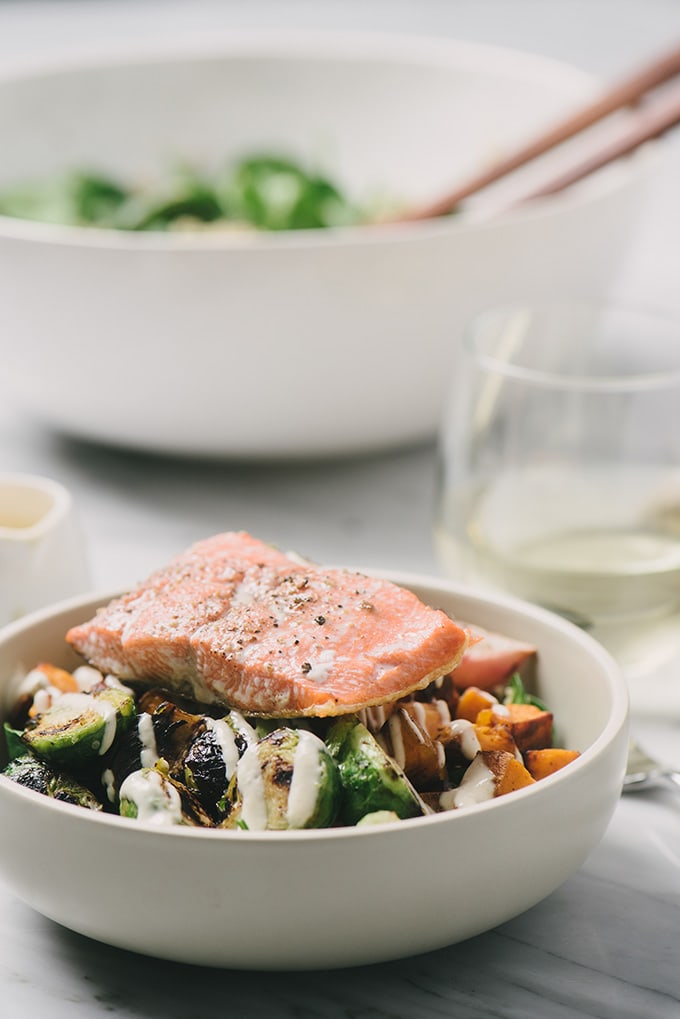
Did you make this Salmon Quinoa Bowl? I’d love to know how it turned out! Leave a comment and a rating below.
While you’re at it, let’s be friends – follow me on Pinterest and Instagram for the latest and greatest.
Recipe
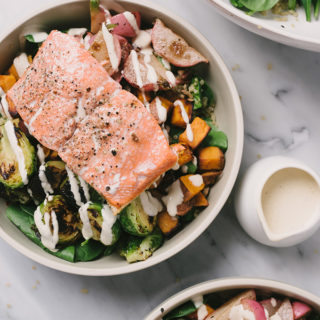
Salmon Quinoa Bowl
Print Recipe Rate this Recipe Pin RecipeRecommended Equipment
- Blender
- Skillet
- Fish spatula
Ingredients
Lemon Tahini Dressing
- ½ c. tahini
- ¼ – ½ c. water
- ¼ c. olive oil
- 1 lemon, juiced
- sea salt, to taste
- cracked black pepper, to taste
Quinoa Bowl
- 1 c. quinoa
- 5 oz 3 c. spinach
- 1 tablespoon sesame seeds
- 1 medium sweet potato, diced
- ½ lb brussels sprouts, halved
- ½ lb radishes, quartered
- 2 tablespoon fat, divided (I used avocado oil)
- 1 lb salmon, cut into 4 4-oz fillets
- sea salt, to taste
- cracked black pepper, to taste
Instructions
Tahini Dressing
- Put all ingredients into a blender and blend until smooth. You may need to add additional water if you prefer a thinner texture. Keeps in the fridge for about a week.
Quinoa Bowl
- Preheat the oven to 425*. Remove the salmon from the fridge and set on the counter so that it can come to room temperature.
- Toss the sweet potato, brussels sprouts, and radishes with 1 tablespoon oil, spread onto a baking sheet (or two if one is too crowded), and roast until charred and tender, stirring occasionally, 25-30 minutes.
- While the vegetables are roasting, cook the quinoa per package instructions.
- While the quinoa and vegetables are cooking, saute the salmon. Heat a skillet over medium-high heat. After slicing the fillets, pat each dry with a cotton kitchen towel or paper towel. Season the flesh with sea salt and cracked pepper.
- One the pan is hot add 1 tablespoon fat to the pan and allow it to heat for about a minute. Add the fillets to the pan skin-side down and then do not touch them. Cook over medium-high heat for 3-7 minutes, or until the flesh is mostly light pink instead of translucent.
- Once most of the flesh is cooked, put a lid on the pan and cook covered for 2-3 minutes, or until the top of the flesh is completely opaque. Alternatively, gently flip the salmon over and sauté an additional one minute, or until the flesh is uniformly pink.
- Remove the salmon from the pan immediately and allow to rest skin side down on a cutting board for a up to 5 minutes.
- Toss the cooked quinoa with the spinach and sesame seeds, then divide b four bowls. Top each bowl with ¼ of the cooked vegetables and one salmon fillet. Drizzle with tahini dressing and serve immediately.


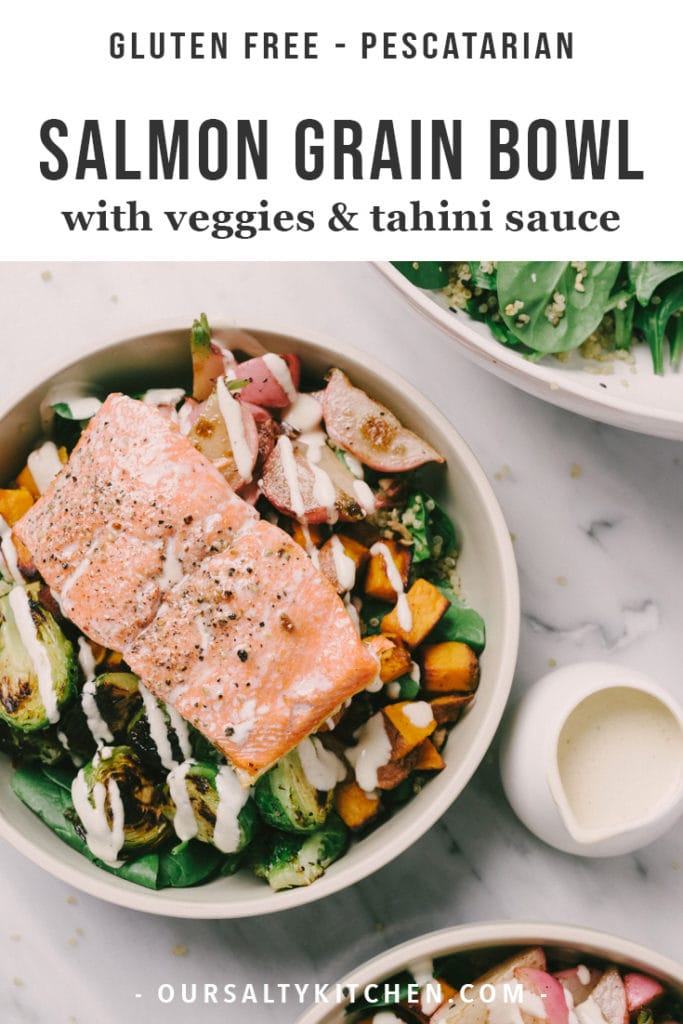

[…] Pan-seared Salmon. Pan-seared salmon requires some extra attention, but if you’re a fan of a crispy exterior and tender flaky interior for your fish, this is the method for you. Learn how to cook perfect pan-seared salmon in my post for Salmon Quinoa Bowls. […]